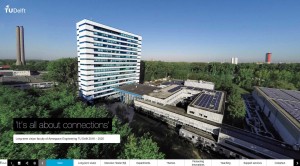A new Long-term Vision
Mid November 2016, my faculty of Aerospace Engineering published its long-term vision in the form of the online magazine “Long-term Vision of the Faculty of Aerospace Engineering TU Delft 2016 – 2020: ‘It’s all about connections“. In this vision the (former) Dean, I as the Director of Education, and the departmental directors, theme organisers, project leaders and others address in personal interviews the question of how the faculty can make an optimum contribution to society at a time when everything is increasingly revolving around connections. 
Since many of my blog followers have no affiliation with TU Delft but do share, I presume, my interest in the vision on engineering education, I have copied the full text about the Bachelor and Master Education into this blog post. A complementary vision on education, more specifically on Online Education, was established by my colleague Renee van de Watering and is available here.
Vision on Bachelor and Master Education 2016-2020
The faculty is currently in an enviable position; it has more students and prospective students than ever before and graduates are finding jobs with ease. According to the Director of Education Aldert Kamp, this doesn’t mean that it can now sit back and rest on its laurels. “If we want to maintain this position for the next ten or fifteen years, we will have to keep our teaching up-to-date and follow the trends in society”, he says.
The faculty of Aerospace Engineering made major changes to its Bachelor´s programmes between 2006 and 2010. It also saw additional measures introduced during the years that followed, as part of the university-wide ‘Charting a course for study success’ programme. As Aldert Kamp remembers it: “The basic premise in 2006 was to find ways of training better engineers”. The updates proved successful, as demonstrated by the accreditation inspection in 2013. “The Bachelor’s programme was deemed world class. The committee was also positive about the Master’s programme, but it didn’t score ‘good or very good’ like the Bachelor’s. So we tried to find out why. What are the requirements for future-oriented Master’s teaching?”
Big data
 “Developments in society and technology are more complex than ever, and are interwoven with developments elsewhere in the world”, he continues. Kamp is referring to developments such as robotisation, artificial intelligence and 3D printing, which have far-reaching implications for the field of aerospace engineering. “We should be preparing our students more for the importance of these factors during their future careers. If I were a Master’s student today, I would want to know more about big data, for instance, which is set to change the way we design products, provide services or maintain systems.” This is an area for special attention for both the faculty and TU Delft as a whole. Kamp is currently heading a project group within the faculty, charged with revitalising the Master´s programmes in the light of ongoing global developments.
“Developments in society and technology are more complex than ever, and are interwoven with developments elsewhere in the world”, he continues. Kamp is referring to developments such as robotisation, artificial intelligence and 3D printing, which have far-reaching implications for the field of aerospace engineering. “We should be preparing our students more for the importance of these factors during their future careers. If I were a Master’s student today, I would want to know more about big data, for instance, which is set to change the way we design products, provide services or maintain systems.” This is an area for special attention for both the faculty and TU Delft as a whole. Kamp is currently heading a project group within the faculty, charged with revitalising the Master´s programmes in the light of ongoing global developments.
They have already identified a number of concrete action points for the next few years. One of them is making the programme more flexible. “More and more students are adopting a do-it-yourself approach. They take an online subject with MIT, for example, and then apply for exemption even if the content isn’t exactly the same as ours”, says Kamp to illustrate his point. “Our degree programmes currently have a fairly rigid structure, partly because the Board of Examiners has to comply with strict rules and regulations. Our students need more leeway, certainly during the Master’s phase but perhaps also during the Bachelor’s.”
Gap year
This brings us to the subject of the gap year. Kamp: “Increasing numbers of students are searching for a deeper meaning to life. Many of them take a year out before starting a Master’s programme. They travel the world, do an internship or try their hand at something completely different.” In principle, this is a positive development. “We see that students who have taken a gap year are generally better students: they have more experience of life and a clearer idea of what they want.” The question is: how far is the faculty prepared to facilitate this? “Should we try to keep a lid on this? If students have already done an internship with Airbus they obviously don’t want to do it again, even if it is a compulsory part of our Master’s programme. So should we cater to this development, and if so, how?” The intake of Master’s students is also becoming increasingly diverse in terms of nationality, previous education and interests. “In the past, students simply continued from our Bachelor’s programme to our Master’s. These days, 60 percent come from other universities. Our teaching will have to be designed to take more account of the wide range of previous education and ambitions of the students.”
Capping the Master’s
One thing is clear: this increased diversity in intake is not without its problems. “The risk of dropping out has also risen. For example, some students are perfectly capable of learning for the exams, but unable to work independently on a research project.” Greater flexibility in the programme could provide a solution. “We could perhaps offer special training clusters, according to previous education and country of origin.” A system of capping is being considered for the international Master’s intake, limiting the number of students and aiming for a good mix of origins and backgrounds. Specific regions or universities will also be targeted for student exchange projects. “The emphasis will be on talent selection. The main thing is that students are up to the programme.”
But as Kamp correctly comments: “Intercultural education is more than simply attracting international students.” This is why the lecturers – in fact all colleagues – should be properly prepared. “How do you prepare for students from India, China, the Netherlands, Germany, America and Africa, each with their own cultural background, all being in one group?” One of the ideas being explored is organising workshops about cultural diversity for academic staff. This concept will be expanded in the years to come.

Bachelor students engaged in aerospace design project work
Student selection for the Bachelor’s
A start has already been made on selecting talented students for the Bachelor’s programmes, when the draw system was discontinued in 2016. In 2016, the draw system was only implemented for half of the available places. An experiment with decentralised selection was conducted for the other half. Prospective students were assigned points for various components, including a mini-MOOC ‘Introduction to Aerospace Engineering’, a motivation test, tests in maths and physics, and a written self-reflection assignment. The process has been fully computerised and if things go according to plan, it will be rolled out for the entire intake in the years to come. An analysis of the effects of selection on student pass rates will be made for the 2016-2017 academic year. This is the perfect cohort, as half of the students were allocated places after a draw and the other half were selected. “We think that we’ve got it right, because only well-motivated students actually get through the selection procedure.”
So that’s the intake side of things. What about the graduates? Kamp has regular meetings with potential employers and other external parties such as Airbus and the Aerospace Advisory Council, as well as internal parties including the Delft Deltas Infrastructures and Mobility Initiative and the Delft Robotics Institute. “They all agree on the importance of teaching students to work within a multidisciplinary team. There is room for improvement in this area.” Multidisciplinary does not simply mean that researcher in aerodynamics is able to have a discourse about a design problem with an expert in lightweight structures. They must also able to communicate with people who have no idea about what engineers do, such as economists or psychologists. “We obviously need to keep training specialists, but we need to look outwards too”, says Kamp. The Bachelor’s programmes already provide this flexibility in the shape of a series of design projects and practical lessons, but students in the Master’s phase spend nine months working individually on a graduation project. “If we want to train our students to operate in the society of the future, we have to give them more choices and let them work more in teams.” This is currently being investigated as part of the Master’s revision project.
Personal, Professional and Career skills
Kamp has his own ideas on the subject. He thinks graduates should be trained for different profiles, for example. “We train most if not all our students to become research specialists. But most of them end up in industry. We should give the students who have already made this decision more scope to develop the professional skills they need for their intended career and ambitions.”

In the Master’s we train most, if not all, students to become a researcher or specialist, while there exists a whole spectrum of professional roles for our graduates.
The students who want to continue in research can expand their theoretical knowledge and develop their research skills. “And then there’s another group who are thinking about starting their own company. Give them a chance to include entrepreneurship in their Master’s programme.” Kamp would like to see more focus on careers after graduation. “Everyone should experience working as a part of a multidisciplinary team during the Master’s programme, as well as working solo. And teach students to think harder about the career they want and to make choices regarding their profile, by preparing them to apply for jobs, etc.” There are plenty of isolated activities for practicing job applications, but Kamp wants a more structured approach that would include all graduation students. The most important message, however, is that rather than remaining static, the world is changing more and more rapidly and education must change with it: “This applies to both our teaching methods and the content of our programmes.”
The implementation
In future blogs I aim to discuss the implementation of this vision and the debates about new unforeseen developments that will undoubtedly take place in the coming years. Particularly the exploration of the Master’s that offers more space and flexibility for students who have specific interests, ambitions or career prospects and who have more a Do-It-Yourself ethic, is high on my agenda and will be revisited in one of my blog posts soon. Meetings with project groups have already produced some conceptual ideas that have to be designed into scenarios on the drawing board. The real challenge will of course be to find the consensus and capacity to develop and implement the changes.



